What To Know If You’re Swimming This Summer
Denise Vasi
Learn how to prevent child drowning with these tips from a certified swim instructor. Just a few years ago, the American Academy of Pediatrics (AAP) recommended that parents wait until their children were four years old or older to learn how to swim but on March 15th, 2019 the AAP released updated water safety guidelines. Thanks to new evidence, the APP’s new recommendations now state that children should start swimming lessons as early as one-year-old to help reduce the risk of drowning.
Whether it’s a local beach, a neighbor’s pool, or you’re headed out on a family vacation, chances are you’ll find yourself and your little ones around water this summer. Most people look at water activities as a way to beat the heat and tire the kids out, but some forget the immense responsibility that comes with all the fun.
Drownings happen all year round, but the summer months bring an increased amount of accidental drownings and water-related injuries. Nearly 1,000 children drown each year in the United States, and more than half of them are within 10-25 yards of a parent or adult. Babies are most at risk at home in a bathtub, bucket, or even a toilet; any small amount of water that can cover a child’s mouth and nose puts them at risk.
Drowning is the leading cause of unintentional death for children ages 1 to 4 years old. Most of these drownings occur in swimming pools. For children between 5 and 14 years old, drowning is the second leading cause of death and is more likely to take place in natural bodies of water—oceans, rivers or lakes.
“Children should have respect for any body of water,” says Pamela Baldwin, certified swim instructor and owner of FINtastic Swim School. “They should never feel that it is OK to go near the water without an adult or when old enough, without an adult’s permission and supervision.”
Drowning Happens Quickly
Drowning rarely looks like what we’ve seen in movies; the respiratory system makes it nearly impossible to scream for help.
“[It] is silent and only takes seconds.” says Baldwin.
“There is no such thing as being ‘water safe.’ Supervision by someone who knows CPR/First Aid is the only way to prevent drowning. Never think that you have time to walk away from your child when you are around water—this includes the bathtub. If you were not there to witness exactly what happened, then you may not know how to help most efficiently.”
Baldwin shares these scary examples on FINstatsic Swim’s Facebook page:
- In the 10 seconds it takes to get a towel, your child can become submerged.
- In the 2 minutes it takes to answer a phone call, your child can lose consciousness.
- In the 4-6 minutes it takes to answer the front door, your child can sustain permanent brain damage or die.
In 2018, American Olympic skier Bode Miller’s 19-month-old daughter drowned after she found her way into her neighbors’ swimming pool. These are very frightening but realistic examples of what can happen in seconds.

The Importance of Swim Lessons
Safety is the number one reason your child should take swimming lessons. Swimming lessons can help reduce the risk of drowning by 88 percent in children between the ages of 1 and 4. While learning to swim will increase the chances of survival, it does not guarantee it.
I personally found myself in a situation at ten years old that would keep me cautious of the water for the rest of my life. When my daughter turned seven months, we decided she would start lessons. The priority at the time was not actual swimming; it was about getting her comfortable and confident in the water.
As she has gotten older, the focus has changed. Being able to “monkey walk” the perimeter of the pool, being able to identify and get to the pool exits and being able to pull herself out of the pool are most important.
I urge parents to understand that swimming is not just another recreational activity; it is not the same as ballet or soccer. Knowing how to swim is a life-saving skill.
“When [children] are around 6 months old, it is time for pool lessons for more familiarization and to start to learn to swim process,” Baldwin says. “Ultimately, you want your child to be an independent swimmer before they turn 4.”
As far as what to look for regarding a swim school or instructor, she says, “Look for a swim school that matches your parenting style. Keep trying if the first one doesn’t work. Every lesson is a step closer to your ultimate goal of having an independent swimmer that loves the water. Just because your friend’s child learned one way, does not mean your child will learn the same way or in the same amount of time.”
Pool Safety
Water safety always starts with constant supervision! When was your last CPR class? Does your child’s caretaker know CPR/First Aid?
For an at-home pool, fence the pool with a self-closing, self-latching gate. A four-foot-high, unclimbable, four-sided fence is recommended. Locks, alarms and pool covers are excellent extra layers of protection, but they are never substitutes for a fence and supervision.
Covers are less effective than fences due to the simple fact that a cover can be accidentally left open. There’s also the possibility for breakage or a power outage that could prevent the cover from closing properly.
Install extra locks on doors leading from the house to the pool and if you don’t already have a home security system, install alarms that signal when someone uses the door to go outside. Keep a phone near you in case you need to call 911, but don’t be tempted to use it to scroll your Instagram feed or text your best friend.
If you’re visiting a pool for the first time, familiarize yourself with your surroundings. Look for the entry and exit points of the pool. Knowing the depths of the pool is very important. Locate where it is shallow and where it gets deep.
If you’re having a pool party, consider hiring a lifeguard; invited guests can easily be distracted from their lifeguard duties. Switch “water watchers” every 30 minutes.
Baldwin highly recommends having a placard made, detailing all the pool rules, and placed in sight by the pool. Getting the whole family involved in making pool rules helps to keep everyone accountable.
Open Water Safety
Expect the unexpected when it comes to open water. Water depth can change anywhere at any time. Beware of strong or weak currents; check in with the lifeguard as soon as you arrive because they may have valuable information regarding currents and tides.
Learn the meaning behind colored beach flags. They vary from beach to beach. Assign your children designated swimming areas that are appropriate for their skill level. This is important with siblings of different ages. The “buddy system” is a great rule to implement among older, skilled swimmers, such as teens and adults.
Put your child in a proper fitting U.S. Coast Guard-approved life jacket when boating or participating in water sports and check the weather forecast whenever you’re going out on the water to ensure that conditions are safe.
Inner Cities & Low Cost Classes
According to the USA Swimming Foundation 64% of African-American, 45% of Hispanic/Latino, and 40% of Caucasian children have little to no swimming ability.
Children in inner urban cities are less likely to learn how to swim simply due to less exposure to pools. The YMCA is committed to teaching children how to swim and they offer several low-cost classes across the country. Swim for Life is a specific program which offers free water safety swim lessons for children and adults based on income qualifications.
Pamela Baldwin is recognized as one of the top swimming instructors in Los Angeles. With a twenty-year swimming background including 10 years of lifeguard experience, 10 years of competition, four years of Olympic technique training she founded FINtastic Swim School. FINtastic focuses on the whole child and their own unique learning process. The goal of their attentive instructors is to nurture a child’s natural tendencies to create a confident independent swimmer, all while educating children on the joys and importance of swimming,









